Andie Parry, Ashka Jhaveri, Annika Ganzeveld, Brian Carter, and Peter Mills
The Iran Update provides insights into Iranian and Iranian-sponsored activities abroad that undermine regional stability and threaten US forces and interests. It also covers events and trends that affect the stability and decision-making of the Iranian regime. The Critical Threats Project (CTP) at the American Enterprise Institute and the Institute for the Study of War (ISW) provides these updates regularly based on regional events. For more on developments and in Iran and the region, see our interactive map of Iran and the Middle East.
Note: CTP and ISW have refocused the update to cover the Israel-Hamas war. The new sections address developments in the Gaza Strip, the West Bank, Lebanon, and Syria, as well as noteworthy activity from Iran’s Axis of Resistance. We do not report in detail on war crimes because these activities are well-covered in Western media and do not directly affect the military operations we are assessing and forecasting. We utterly condemn violations of the laws of armed conflict, Geneva Conventions, and humanity even though we do not describe them in these reports.
Key Takeaways:
- Palestinian militias in the Gaza Strip conducted rocket attacks into Israel at roughly half their usual rate on October 27.
- The IDF conducted five raids into the Gaza Strip on October 27, and IDF ground forces will expand their operations overnight.
- Palestinian militants clashed with Israeli security forces across the West Bank at a higher rate on October 27, amid Israeli arrest raids.
- Iranian-backed militants, including Lebanese Hezbollah (LH), resumed attacks as part of an ongoing attack campaign targeting IDF radar and sensor sites and military targets.
- The United States conducted two self-defense airstrikes targeting “IRGC-affiliated targets” in response to drone and rocket attacks against US forces in Iraq and Syria.
- The Iran-backed Houthi movement conducted a drone attack targeting southern Israel on October 27.
- Iran and its Axis of Resistance are continuing to signal their willingness and capability to escalate against the United States and Israel from multiple fronts.
Gaza Strip
Axis of Resistance campaign objectives:
- Erode the will of Israeli political establishment and public to launch and sustain a major ground operation into the Gaza Strip
- Degrade IDF material and morale around the Gaza Strip
Palestinian militias in the Gaza Strip conducted rocket attacks into Israel at roughly half their usual rate on October 27.[1] The al Qassem Brigades—Hamas’ militant wing—claimed responsibility for five indirect fire attacks.[2] Three of these attacks targeted Tel Aviv and injured several Israeli civilians there.[3] Saraya al Quds—the militant wing of Palestinian Islamic Jihad (PIJ)—claimed responsibility for six rocket attacks, including an attack using a Badr-3 rocket on Ashkelon.[4] The Badr-3 rocket is produced in Gaza and has a 400 kilogram warhead, whereas Palestinian militias most frequently fire Qassem rockets with five kilograms of explosives.[5] Axis of Resistance-affiliated media reported one unclaimed anti-tank munition attack on Israeli forces.[6]
Recorded reports of rocket attacks; CTP-ISW cannot independently verify impact.
Recorded reports of rocket attacks; CTP-ISW cannot independently verify impact.
Israeli Ground Operations in the Gaza Strip
The IDF conducted five raids into the Gaza Strip on October 27, and IDF ground forces will expand their operations overnight.[7] The IDF 13th Fleet deployed a tactical unit, ships, and aircraft in a naval raid on Rafah beach in the southern Gaza Strip on October 27.[8] An IDF spokesperson stated that the unit ”destroyed terrorist infrastructures of the Hamas terrorist organization and operated in a compound used by the organization's naval commando forces.”[9] The IDF 36th Division also conducted a raid into central Gaza near Shujayyah using infantry, armor, and engineering units supported by helicopter gunships.[10] The IDF stated the Shujayyah operation had dozens of targets including anti-tank guided missile launch positions and Hamas operational headquarters and militants.[11] Axis media and social media users reported three other armed clashes between Palestinian militias and IDF troops in central and northern Gaza.[12] The IDF spokesperson disclosed IDF group operations in the Gaza Strip will intensify overnight.[13]
The al Qassem Brigades and Axis media incorrectly framed the naval raid engagement as a success for its militants by claiming they forced an IDF withdrawal and air engagement.[14] US military doctrine defines a raid as “an operation to temporarily seize an area in order to secure information, confuse an enemy, capture personnel or equipment, or to destroy a capability culminating with a planned withdrawal.”[15] The IDF withdrawal after the operation is consistent with the US military doctrinal definition of a raid, which includes a planned retrograde at the end of the mission. The IDF used air support to assist their elements’ withdrawal during the naval raid.[16]
West Bank
Axis of Resistance campaign objectives:Draw IDF assets and resources toward the West Bank and fix them there
Hamas leadership is urgently calling for further resistance in the West Bank. Hamas Political Bureau leader Ismail Haniyeh called for louder condemnation of Israeli attacks in the Gaza Strip and the West Bank.[17] Haniyeh claimed on October 7 that the Al Aqsa Flood Operation began in the Gaza Strip and will extend to the West Bank.[18] A cybersecurity monitoring group said it had observed the largest single internet disruption in the Gaza Strip since hostilities began, amounting to a “total or near total blackout of internet service.”[19] Hamas Political Bureau member Hussam Badran made an urgent appeal to people in the West Bank that “this is the time for weapons.”[20]
Hamas and PIJ claimed their militants died while confronting IDF forces in Jenin. Saraya al Quds mourned a prominent field commander in its Jenin Battalion who died “supporting Gaza” in Jenin.[21] Hamas mourned three militants who died in clashes in the West Bank in Jenin and Qalqiya.[22] Ismail Haniyeh noted that the martyrs of the al Qassem Brigades are the same as Saraya al Quds Brigades and LH throughout the country in a speech on October 26.[23]
Palestinian militants clashed with Israeli security forces across the West Bank at a higher rate on October 27, amid Israeli arrest raids. The IDF, Shin Bet, and Border Police forces arrested 36 Palestinians, including 17 Hamas operatives, in the West Bank. Israel is dismantling Hamas and PIJ command structures in the West Bank.[24] The Palestinian Authority reported that four Palestinians died overnight during Israeli raids in the West Bank.[25]ISW recorded 14 distinct clashes between Palestinians and Israeli security forces across the West Bank. Saraya Al Quds-Tubas Brigade used an explosive device during clashes with IDF forces in Tubas.[26] CTP-ISW recorded two other instances of Palestinians using IEDs in the northern West Bank.[27]
CTP-ISW recorded eight anti-Israel demonstrations, a majority of which occurred after the internet cuts in the Gaza Strip. Hamas and the PIJ-affiliated Quds News Network reported on their Telegram pages that there are calls for marches in all areas of the West Bank and Jerusalem following the interruption of communication in the Gaza Strip.[28] Palestinians in Ramallah chanted “if you have a rifle, you should either kill a Jew or give it to Hamas.”[29]
This map is not an exhaustive depiction of clashes and demonstrations in the West Bank.
Southern Lebanon and Golan Heights
Axis of Resistance campaign objectives:
Draw IDF assets and resources toward northern Israel and fix them there
Set conditions for successive campaigns into northern Israel
Iranian-backed militants, including Lebanese Hezbollah (LH), resumed attacks as part of an ongoing attack campaign targeting IDF radar and sensor sites and military targets. LH claimed six anti-tank guided missile (ATGM) attacks on IDF positions along the border with Lebanon on October 27. This is consistent with its rate of attacks prior to October 26.[30] LH did not claim any attacks on October 26 for the first time since CTP-ISW began recording LH claims on October 11.[31] IDF forces responded to the ATGM attacks with artillery fire targeting locations in southern Lebanon where militants had fired into Israel.[32] LH claimed its attacks inflicted ”confirmed casualties”, but the IDF denied that it suffered any casualties.[33] LH has acknowledged that at least 44 of its fighters have died since October 9 due to Israeli attacks responding to LH attacks on IDF forces and Israeli communities along the Lebanese border.[34]
Recorded reports of attacks; CTP-ISW cannot independently verify impact.
Iran and Axis of Resistance
Axis of Resistance campaign objectives:Demonstrate the capability and willingness of Iran and the Axis of Resistance to escalate against the United States and Israel on multiple fronts
Set conditions to fight a regional war on multiple fronts
The United States conducted two self-defense airstrikes targeting “IRGC-affiliated targets” in response to drone and rocket attacks against US forces in Iraq and Syria.[35] The United States targeted weapons and an ammunition storage facility near Albu Kamal, Syria.[36] US Defense Secretary Lloyd Austin highlighted Iran’s role in attacks against US forces in his statement acknowledging the US airstrikes.[37] A US defense official said that the United States selected the targets to “send a message” to militia groups while “mitigating the risk of escalation.”[38] A local Syrian opposition outlet reported that the airstrike targeted a building used to “hold meetings and receive people coming from Iraq.”[39] It added that the last meeting was held a “few days ago” with “leaders” from the IRGC.[40] The same source reported no casualties in the airstrikes.[41]
The Islamic Resistance of Iraq launched one drone at US forces at Ain al Assad airbase, Iraq on October 27 in response to the US airstrikes.[42] The Islamic Resistance of Iraq claimed the attack roughly 10 hours after the US airstrikes. Iranian state media and local media reported two other rocket attacks targeting US facilities in northeastern Syria on October 26-27.[43] The United States did not confirm these attacks, nor did the Islamic Resistance of Iraq claim the attacks.
The Iran-backed Houthi movement conducted a drone attack targeting southern Israel on October 27.[44] The IDF said that it intercepted an "unknown aerial target” over the Red Sea on October 27.[45] At least two unspecified drones originating in the “Red Sea area” struck Egyptian territory near Taba, a resort town adjacent to Eilat, Israel, and near Nuweiba, 70 kilometers from the Israeli border.[46] The US Navy warship USS Carney intercepted nearly 20 drones and missiles launched by the Houthis from Yemen on October 18.[47]
Iran and its Axis of Resistance are continuing to signal their willingness and capability to escalate against the United States and Israel from multiple fronts. Iranian Foreign Affairs Minister Hossein Amir Abdollahian stated in an interview with NPR on October 27 that Palestinian and Lebanese resistance groups have plans that are “more powerful and deeper than what [the United States] has witnessed.”[48] Abdollahian has previously issued similar warnings. He warned on October 14 that the Axis of Resistance has its “hands on the trigger” and will respond to Israel “at an appropriate time” if Israel continues to attack the Gaza Strip.[49] Abdollahian subsequently warned on October 16 that Iranian-backed militias would imminently take “preemptive actions” against Israel.[50] Abdollahian issued the latter warning two days before Iranian-backed Iraqi militias conducted attacks on US forces in Iraq on October 18. These attacks marked the first attacks on US forces in the region since the start of the Hamas-Israel war on October 7. Lebanese Hezbollah Deputy Secretary General Naim Qassem echoed Abdollahian’s warnings on October 27, stating that the United States and Israel “do not know what the days will hold” if Israel continues its attacks.[51] Qassem made this comment in a meeting with Iranian Parliamentary National Security and Foreign Policy Committee Deputy Chairman Ebrahim Azizi in Beirut.
Iranian Friday prayer leaders echoed the above rhetoric in their sermons on October 27. Tehran Interim Friday Prayer Leader Ali Akbari discussed the connected “regional resistance network” encompassing Palestine, Lebanon, Iraq, Yemen, Syria, and Iran and warned that “everyone is ready.”[52] Mashhad Friday Prayer Leader Ahmad Alam ol Hoda separately stated that the Iranian government and people should be ready to go to the front with Israel as soon as Supreme Leader Ali Khamenei issues an order to do so.[53] Alam ol Hoda’s calls for mobilization are consistent with previous regime efforts to generate momentum for the Hamas-Israel war among the Iranian public, such as launching an online campaign to sign up volunteers to fight Israel.[54] CTP-ISW has previously noted that Alam ol Hoda is known for his ultra-hardline stances and provocative views, which means that his statements do not always reflect the regime's official positions.[55] Alam ol Hoda called on vigilantes to enforce mandatory veiling in the aftermath of the 2022-2023 Mahsa Amini movement, for example.[56]
Iranian Deputy Foreign Affairs Minister Ali Bagheri Kani discussed the Hamas-Israel war with Hamas’ International Relations Office head and Political Bureau member Musa Abu Marzouk in Moscow on October 27.[57] Bagheri Kani stated that Iran seeks an immediate ceasefire in the Hamas-Israel war and the provision of humanitarian aid to Gazans.[58] The official Hamas readout of the meeting notably excluded Bagheri Kani’s call for a ceasefire.[59] Marzouk told Saudi-owned Al Arabiya on October 27 that Hamas is trying to bring in all parties, including Iran and Lebanese Hezbollah, that “want to fight with us.”[60]
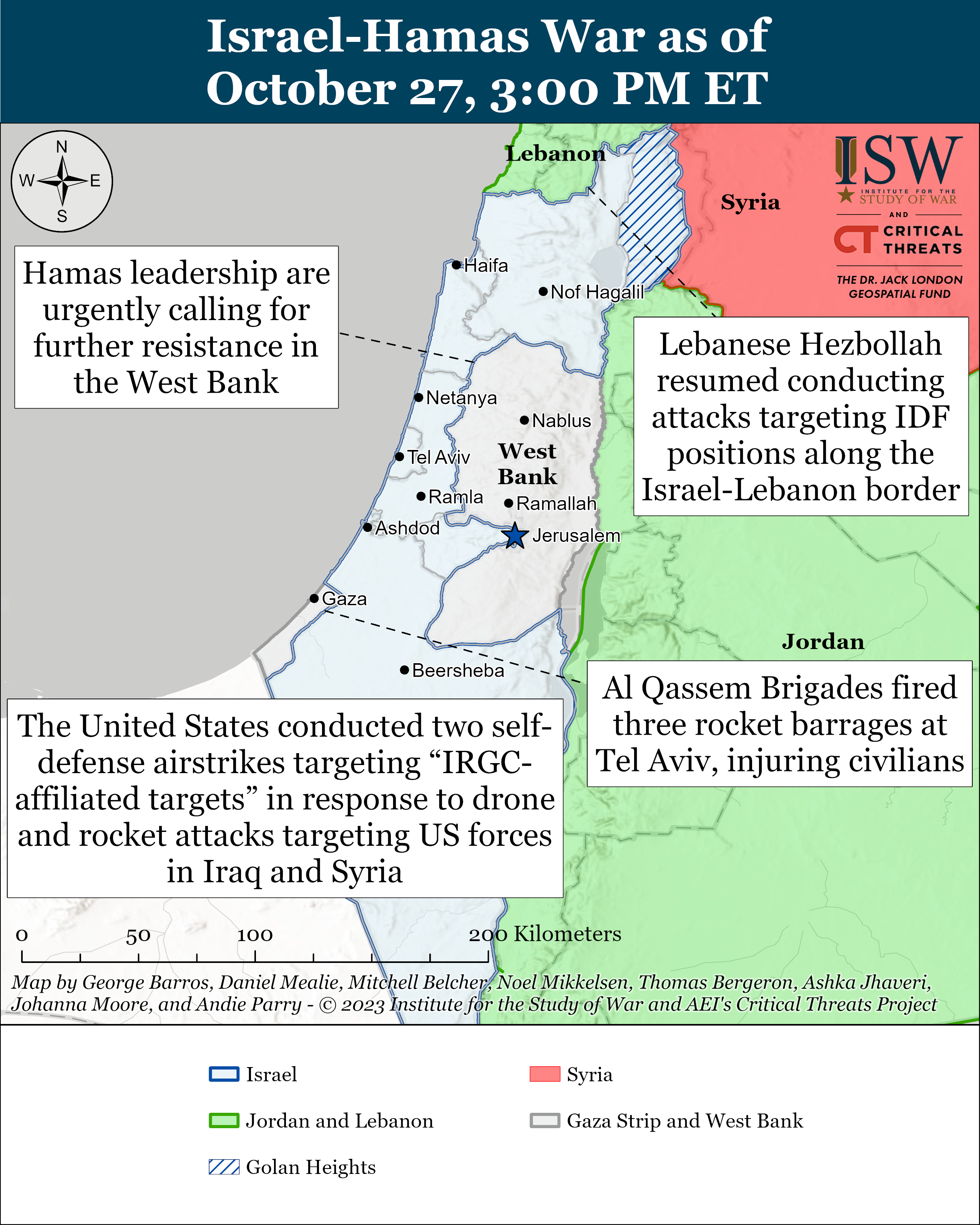
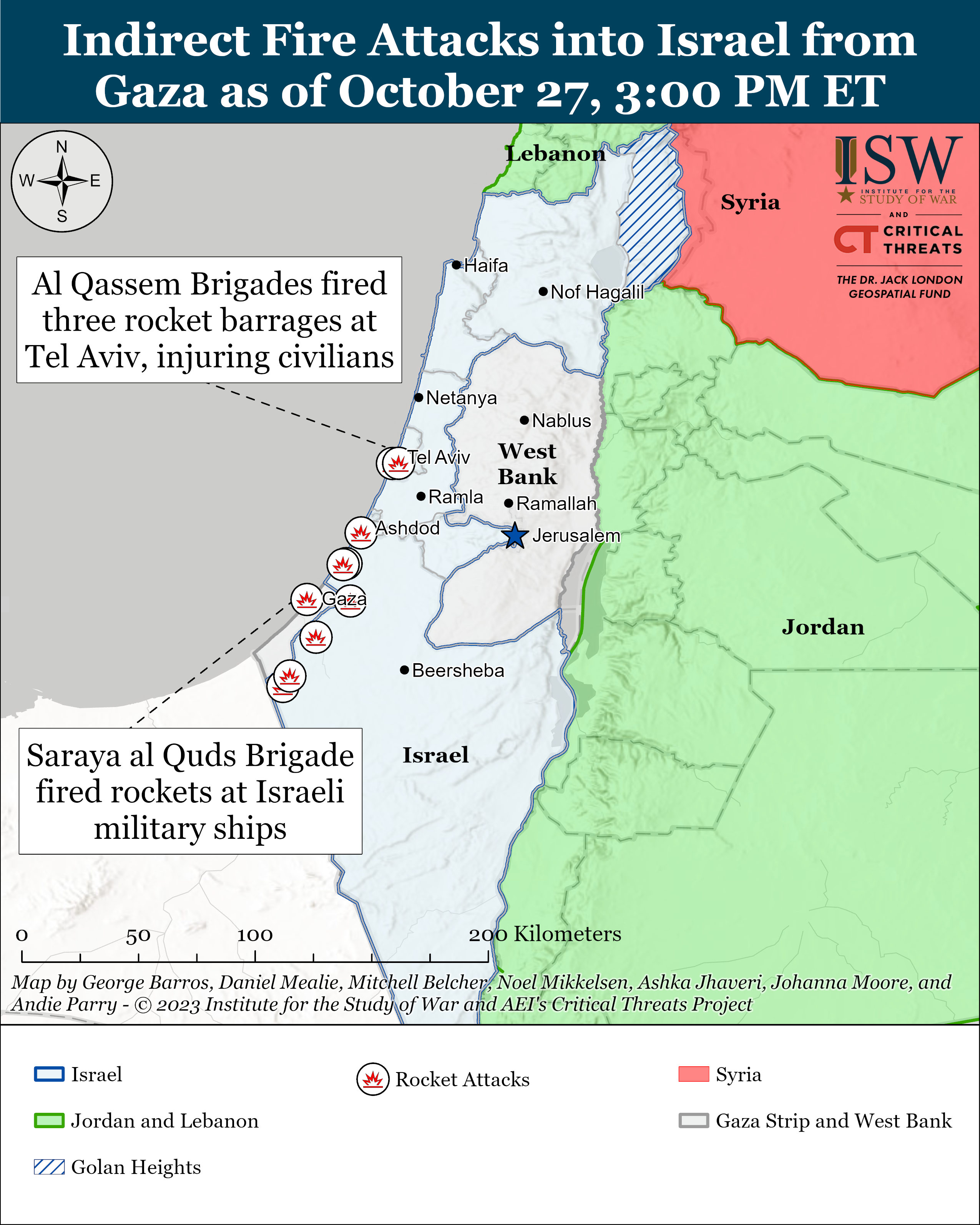
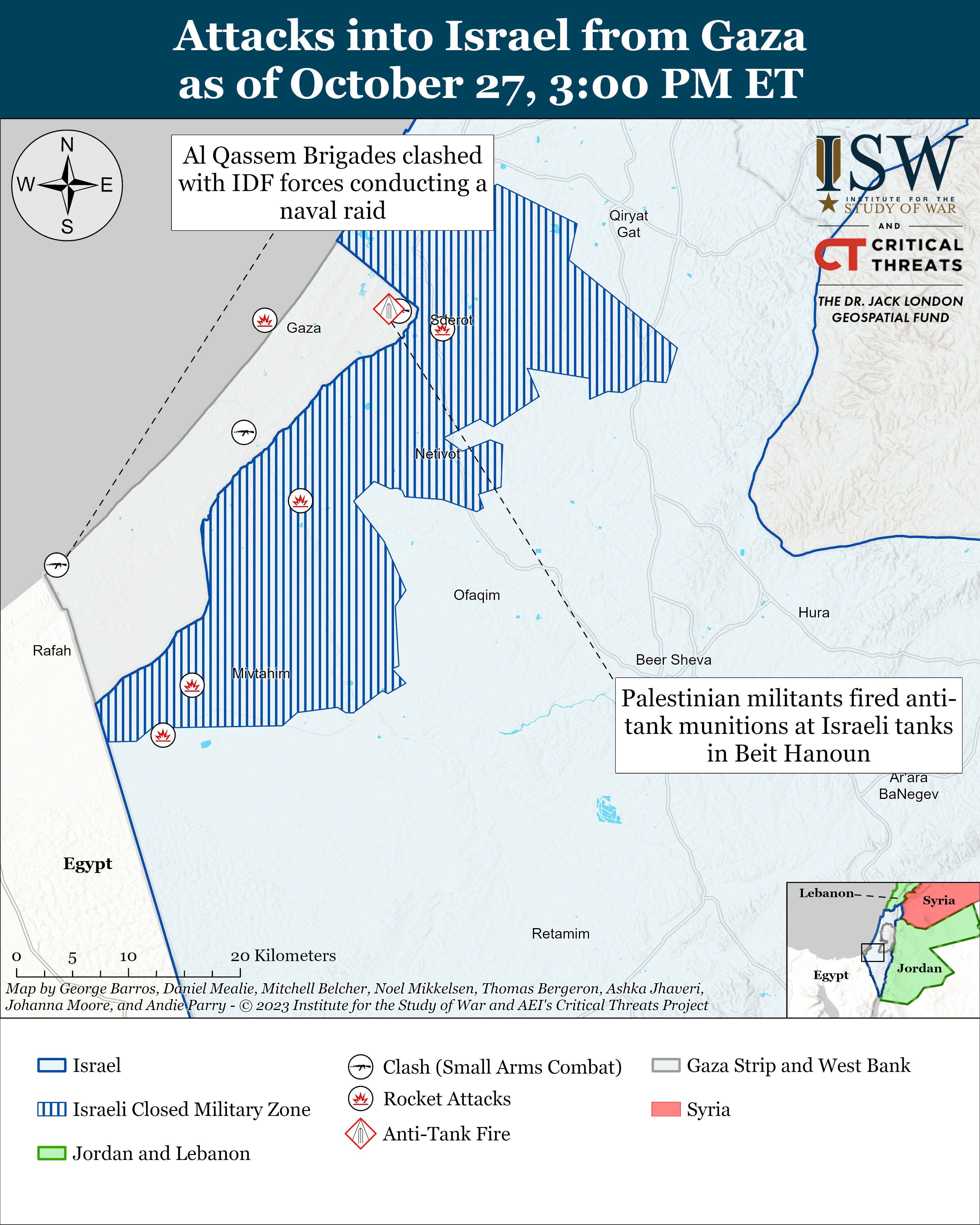
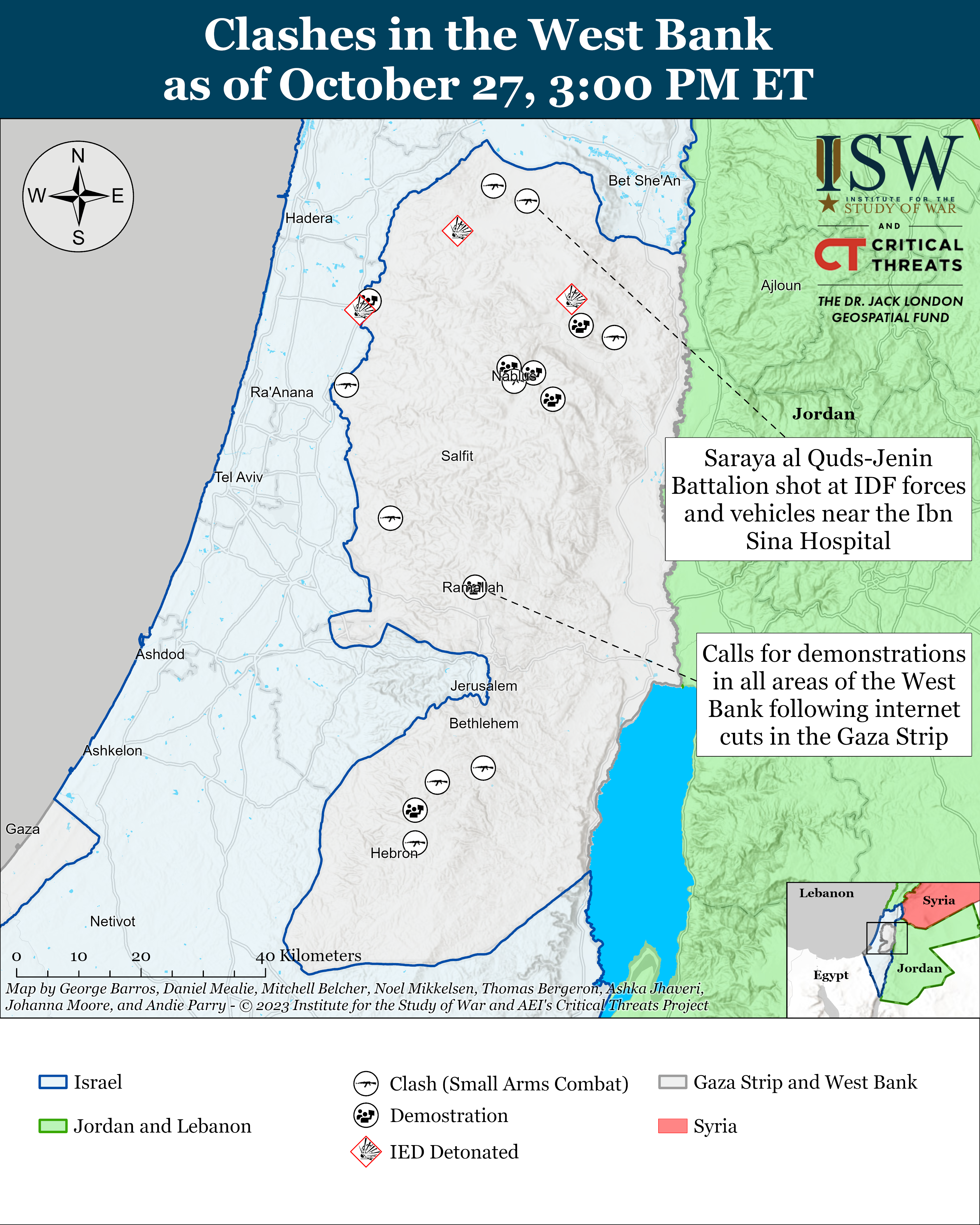
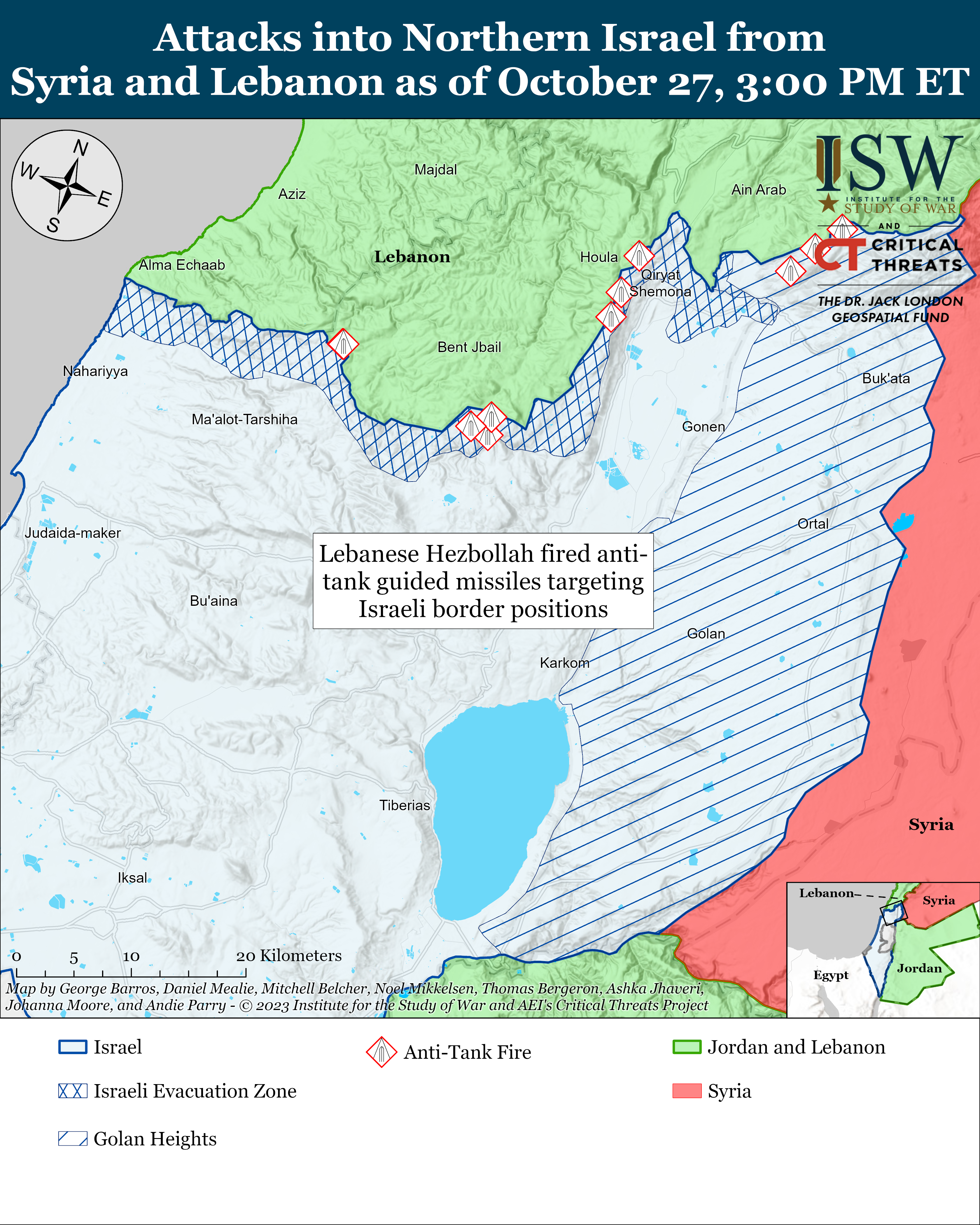
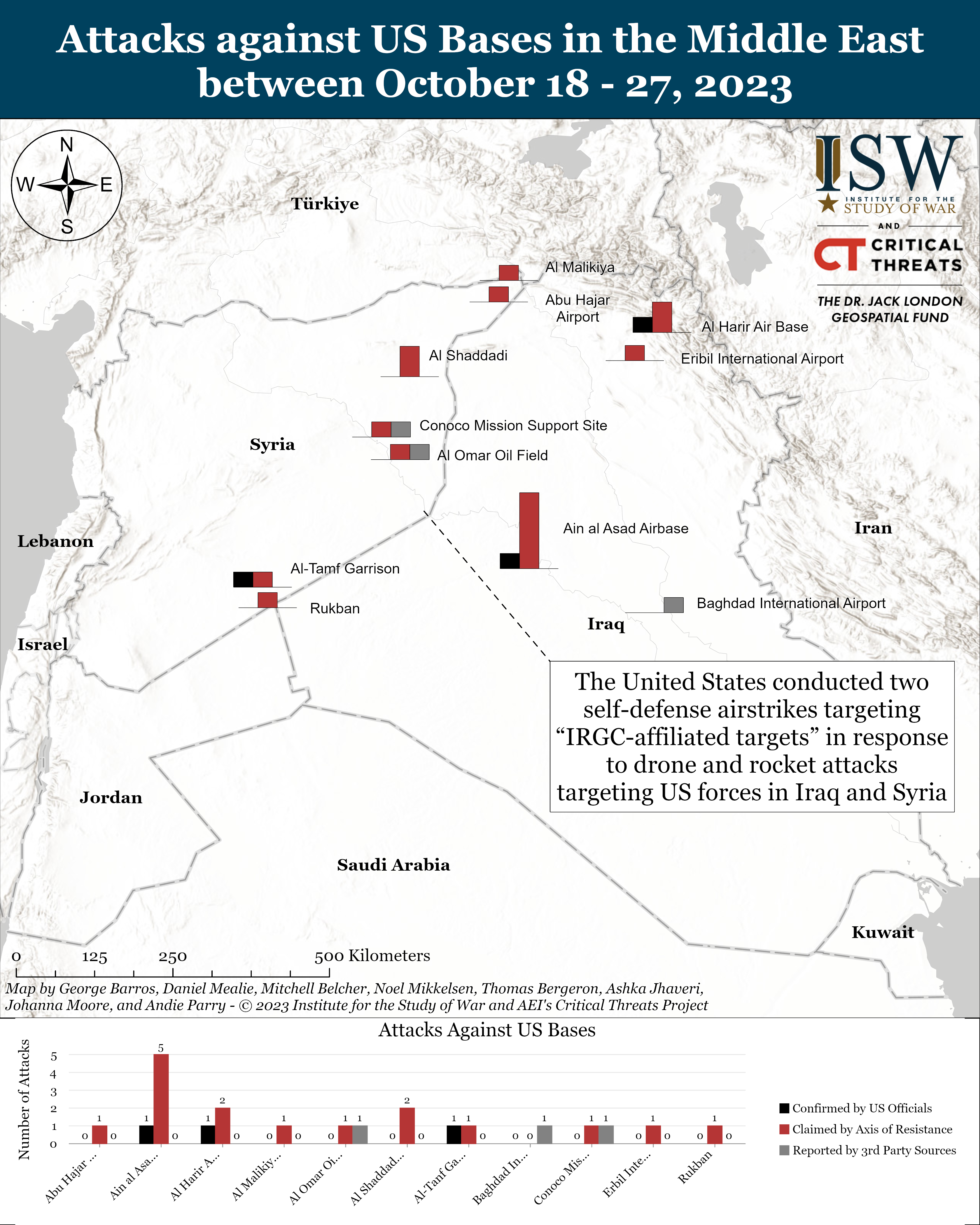
No comments:
Post a Comment